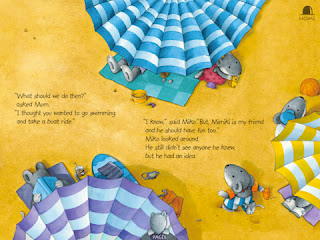So when Betsy Bird announced a new poll on her Fuse #8 blog for top picture books and chapter books, I was very excited. It's fun to consider what stories stand the test of time, and what new authors and books are essential to any bookshelf. And for dotMomming, I want to know if the best books for kids are becoming available in digital format.
The current poll repeats the enormous feat Betsy pulled off in 2009. Here are the top 10 picture books that made the list then:
- Where the Wild Things Are by Maurice Sendak (1963)
- Goodnight Moon by Margaret Wise Brown (1947)
- The Very Hungry Caterpillar by Eric Carle (1979)
- The Snowy Day by Ezra Jack Keats (1962)
- Don’t Let the Pigeon Drive the Bus by Mo Willems (2003)
- Make Way for Ducklings by Robert McCloskey (1941)
- Harold and the Purple Crayon by Crockett Johnson (1955)
- Madeline by Ludwig Bemelmans (1939)
- Millions of Cats by Wanda Gag (1928)
- Knuffle Bunny: A Cautionary Tale by Mo Willems (2004)
Where the Wild Things Are? Nope. And judging by Maurice Sendak's feelings about e-books, it would take a lot of convincing to bring about an app.
Goodnight Moon? What you find in app format is not the picture book. Very Hungry Caterpillar? Here's the first of these top 10 books to appear in the App Store, though it's not the picture book but rather a math game featuring the adorable caterpillar and Eric Carle's lovely fruit. The Snowy Day? Nope.
 Mo Willems' Don't Let the Pigeon Drive the Bus arrived in app format in October 2011 as Don't Let the Pigeon Run This App! (Disney, $6.99). Rather than provide the same content as the paper book, Willems' app lets young readers create their own pigeon stories again and again. Willems is clearly committed to traditional reading and ventured into digital books reluctantly, describing e-books in USAToday, "With all their bells and whistles and word jumbles and assorted narrative killers, after we turn them on, they don't need us."
Mo Willems' Don't Let the Pigeon Drive the Bus arrived in app format in October 2011 as Don't Let the Pigeon Run This App! (Disney, $6.99). Rather than provide the same content as the paper book, Willems' app lets young readers create their own pigeon stories again and again. Willems is clearly committed to traditional reading and ventured into digital books reluctantly, describing e-books in USAToday, "With all their bells and whistles and word jumbles and assorted narrative killers, after we turn them on, they don't need us."Make Way for Ducklings app? Nope. Harold and the Purple Crayon (Trilogy Studios, $6.99) is available in a lovely app format that made the CYBILS app finalist list this year. Madeline? Nope. Millions of Cats? Nope. Knuffle Bunny? Not yet, but there might be hope.
"I didn't want to be some reactionary luddite," Willems says in the USAToday interview. "I'm not saying everything electronic is evil."
Check out the rules for nominating your picks for the top 100 picture books and chapter books on the Fuse#8 blog and then email your favorites to Betsy Bird at Top100Poll@gmail.com. The deadline is 11:59 p.m. Eastern on April 15, 2012.
The Colbert Report
Get More: Colbert Report Full Episodes,Political Humor & Satire Blog,Video Archive
Get More: Colbert Report Full Episodes,Political Humor & Satire Blog,Video Archive




